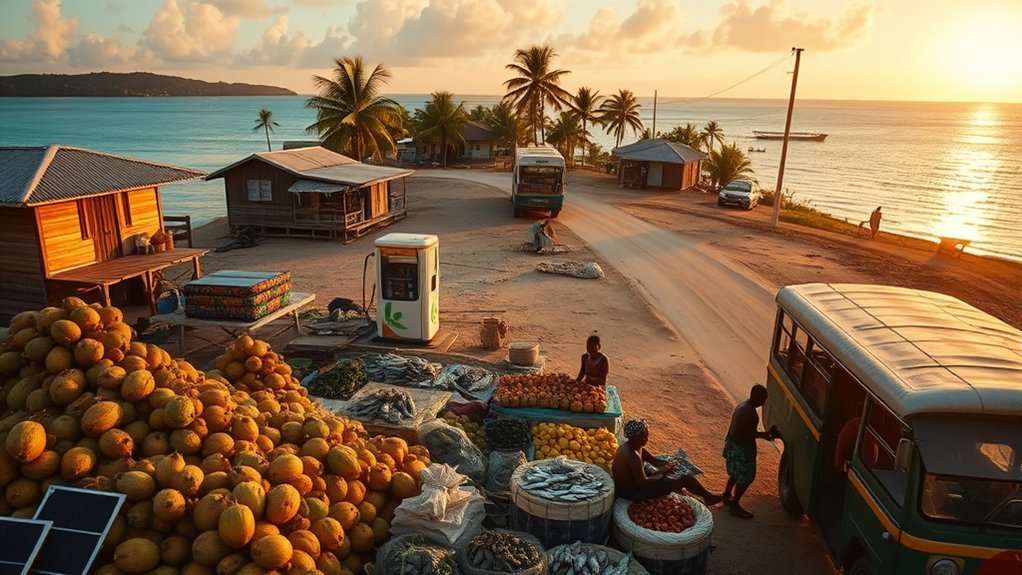You can live in Kiribati for about $532 per month on average, roughly 2.15 times cheaper than the world average. Rent is modest — a one‑bed city apartment runs about $221, utilities ~$40, and local transport costs $0.42 per trip or $16.10 monthly. Groceries and meals are affordable, while healthcare and specialist services are limited. Average after‑tax pay (~$408) won’t stretch far, so keep budgeting tight; more detailed cost breakdowns follow.
Overview of Living Costs in Kiribati
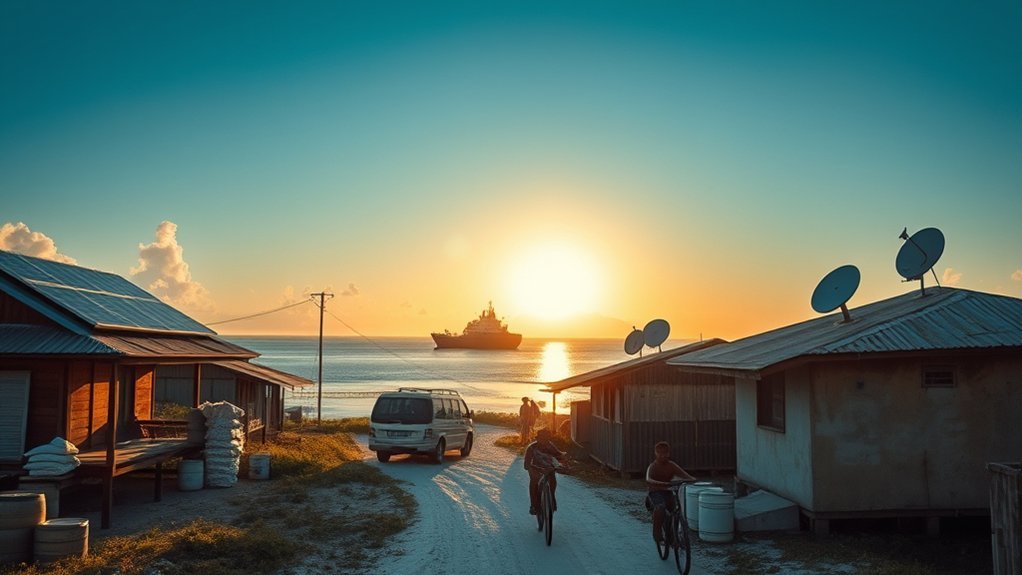
Although geographically isolated, Kiribati offers a particularly low cost of living: at about $532 per month it’s roughly 2.15 times cheaper than the world average and ranks 181st of 197 countries.
You’ll find the average cost driven by modest housing and inexpensive daily expenses. A one-bedroom city-center apartment averages $221, while a three-bedroom runs about $472, showing housing stays below global norms.
Eating out is inexpensive: expect $3.75 for a lunch menu and about $20.70 for a dinner for two, which compares favorably with regional peers.
Local transport is economical, with single tickets at $0.42 and monthly passes for $16.10, reducing commuting impacts on living expenses.
When you evaluate Kiribati’s figures against international averages, the data indicate clear savings primarily from accommodation and transport.
For anyone considering relocation or long-term stays, these comparative metrics frame Kiribati as a low-cost option within island nations.
Typical Monthly Budget for Residents
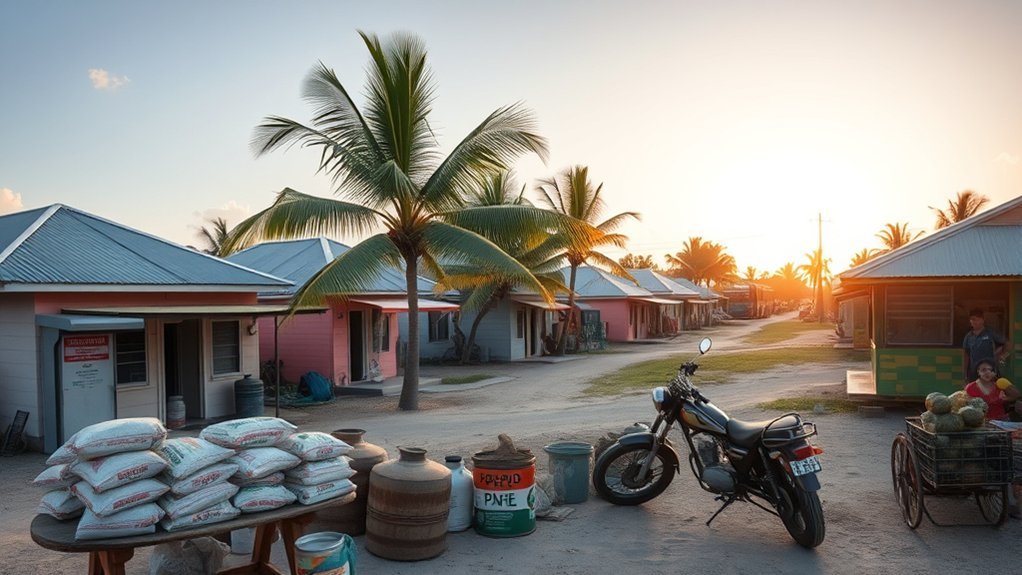
Anyone moving to Kiribati can expect a tight but manageable monthly budget: with an average after-tax salary of about $408 covering roughly 0.8 months of typical expenses, you’ll rely on low housing and transport costs to stretch income.
Moving to Kiribati means a tight but manageable budget: low rent and transport help stretch a modest $408 salary.
For a single person, the cost of living calculated from core line items shows housing at about $221 for a one-bedroom in the city center and utilities near $40, leaving limited margin.
Transport is inexpensive: single fares $0.42 and a monthly pass $16.1. Groceries are affordable by regional standards — milk (1L) $1.19, bread (0.5 kg) $0.74 — so food can be kept lean without luxury.
Eating out remains accessible (lunch $3.75, dinner for two $20.7) but reduces savings. Your typical budget consequently prioritizes rent and basic groceries; discretionary spending quickly erodes the monthly salary, so financial planning or supplementary income is advisable to avoid shortfalls.
Housing and Rental Prices by Area
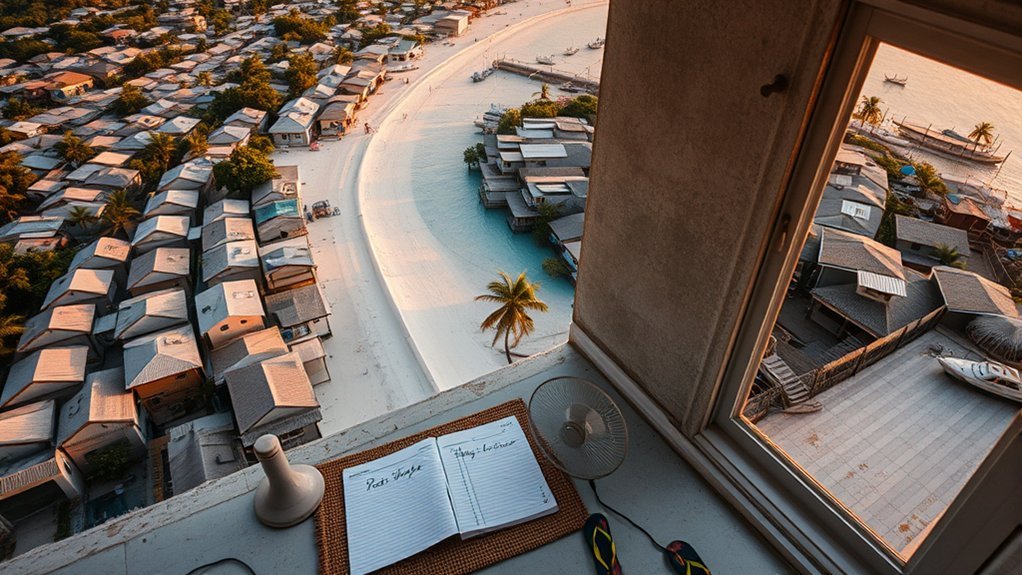
With rent and utilities eating up most of that modest paycheck, you’ll want to understand how housing prices vary across Kiribati.
In urban centers a one-bedroom apartment in the city center averages about $221 monthly, while cheaper one-bed options drop to roughly $156. For families, expect a three-bedroom city-center unit to average near $472 per month.
Rental prices for basic short-term accommodation—hostels and budget hotels—run around $50 per night; higher-end accommodations with extra amenities can climb to $200 per night.
Compared to many countries, housing in Kiribati is relatively affordable, but costs shift by location and type. You’ll pay more for central, larger, or fully serviced units; you’ll pay less in peripheral areas or for basic units.
Expat reports vary: some find good value in local neighborhoods, others pay premiums for imported standards. Use these benchmarks to compare listings and negotiate based on size, services, and exact location within Kiribati.
Food and Grocery Expenses
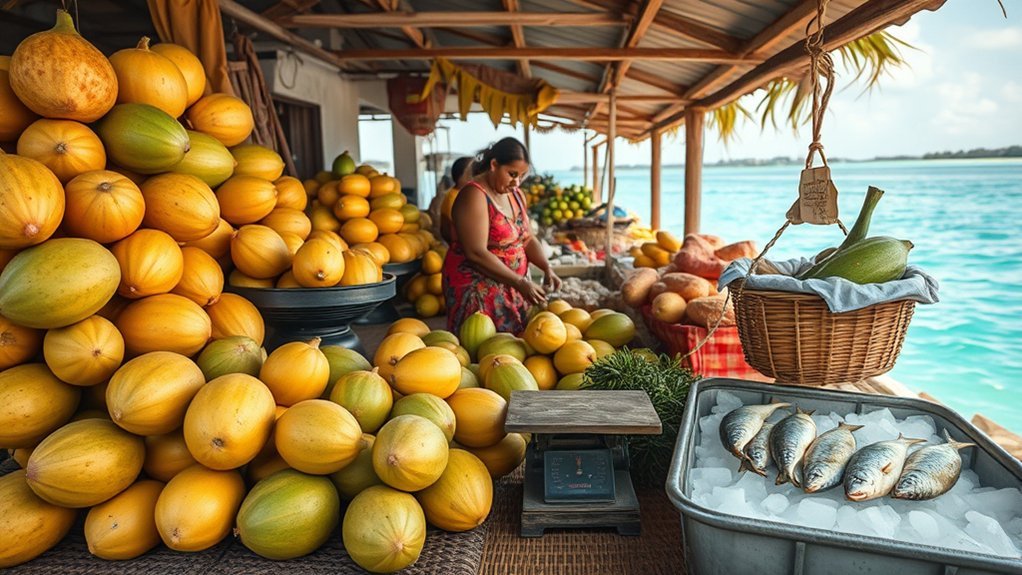
Meals and groceries in Kiribati are generally cheap by global standards: a typical lunch runs about $3.75 and a fast-food combo roughly $4.95, while staples like 1L of milk ($1.19), 0.5 kg of bread ($0.74), a dozen eggs ($1.71), and 1 kg of apples ($2.28) keep basic food costs low. You’ll find grocery prices consistently lower than in many Pacific and Western markets, so your monthly food budget can stay modest if you prioritize staples and local produce. Compare prices: a sit-down lunch and a fast-food meal are within a dollar of each other, while core grocery items cost under $3, reducing the overall cost of living impact from food. Use the table below to quickly scan representative grocery unit prices and relative affordability.
| Item | Unit price (USD) | Category |
|---|---|---|
| Milk | $1.19 | Dairy |
| Bread | $0.74 | Staple |
| Eggs | $1.71 | Protein |
| Apples | $2.28 | Fruit |
Eating Out and Entertainment Costs
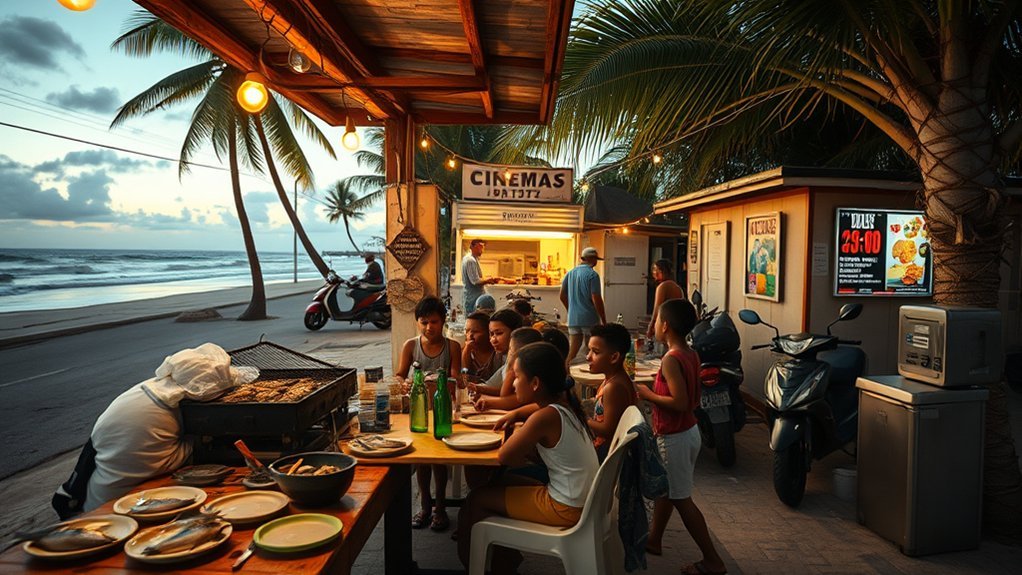
You’ll find eating out in Kiribati is generally affordable: a typical lunch is about $3.75 and fast-food meals run near $4.95.
For a fuller evening, a dinner for two averages $20.70, while nightlife stays cheap — a 0.5L beer is $1.82 and cappuccinos cost roughly $1.89.
These prices compare favorably with many Pacific nations, letting you balance casual daytime meals and modest nightlife without a large budget.
Affordable Local Meals
Food prices in Kiribati stay surprisingly low compared to global averages: a typical lunch runs about $3.75, a McDonald’s-style fast food meal is roughly $4.95, and dining out for two averages $20.70, while a 0.5L beer costs around $1.82 and a cappuccino about $1.89—making social meals and casual entertainment markedly affordable for both residents and visitors. You’ll find affordable local meals that keep the overall cost of living down; dining out in Kiribati competes favorably with regional peers. Use the table below to compare common options and prices.
| Item | Price (USD) | Note |
|---|---|---|
| Lunch menu | $3.75 | Local eateries |
| Fast food meal | $4.95 | McDonald’s-style |
| Dinner for two | $20.70 | Mid-range |
| Cappuccino | $1.89 | Café price |
| 0.5L beer | $1.82 | Pub price |
Nightlife and Drinks
One basic dinner for two at a neighborhood pub runs about AU$12.00, making casual nights out noticeably cheaper than in many Western countries.
You’ll find that nightlife in Kiribati leans informal: pub meals are affordable, while expatriate spots charge more for specialty items. A cappuccino in expat areas goes for about AU$3.00, which gives you a reference point for drinks pricing when cocktails aren’t listed.
Upscale Italian dinners, club cocktails, and movie tickets aren’t consistently priced, so expect variability and occasional premiums in tourist or downtown venues.
Transportation and Fuel Prices
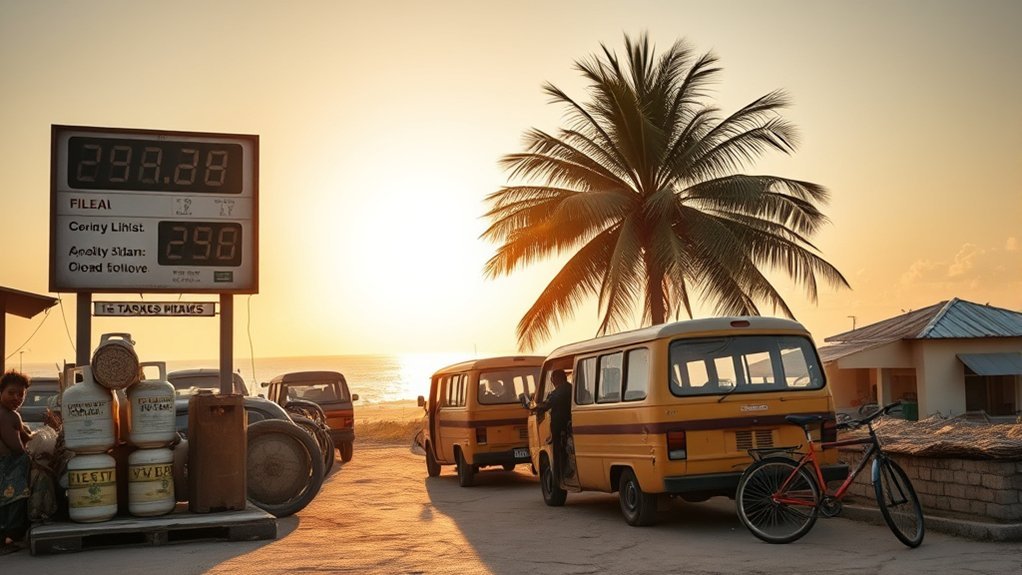
You’ll find public transport in Kiribati very affordable at $0.42 per ticket and $16.10 for a monthly pass, versus about $2.35 per ride on average in the U.S.
If you prefer taxis, expect to pay roughly $6.95 for an 8 km trip, a competitive option for short trips.
Fuel is about $1.06 per liter, slightly above U.S. averages, so driving costs can narrow the gap with private transport.
Public Transport Affordability
Although fuel runs slightly above U.S. levels at about $1.06 per liter versus $0.93, everyday travel in Kiribati remains inexpensive: a single local transport ticket costs roughly $0.42 and a monthly pass is $16.10, while an 8 km taxi ride averages $6.95.
So regular commuters and short-trip visitors will typically pay less than they’d in the United States. You’ll find public transport an affordable option within overall cost of living calculations; buying a monthly pass cuts per-trip expense drastically if you commute regularly.
Transportation costs stay low enough that even with higher gasoline, operating costs don’t push fares up considerably. For budget planning, factor in occasional taxi use but rely on local buses for consistent savings.
Taxi and Fares
Taxis in Kiribati are affordable for occasional trips — an 8 km fare averages $6.95, while a single local transport ticket is about $0.42 and a monthly pass runs $16.10, so regular commuters save substantially by using buses.
You’ll find transportation costs here lower than in many countries, especially compared with U.S. fares. A taxi ride gives point-to-point convenience; frequent use becomes costly compared to a monthly local transport ticket.
Gasoline prices near $1.06 per liter influence car owners’ choices and raise per-kilometer costs for private trips. Use public options for routine travel and taxis selectively for time-sensitive or luggage-heavy journeys.
- 8 km taxi ride: ~$6.95
- Single ticket: ~$0.42
- Monthly pass: ~$16.10
- Gasoline prices: ~$1.06/L
- Public transport vs. U.S.: particularly cheaper
Fuel and Petrol Prices
Because fuel affects both private and public transport costs, expect petrol in Kiribati to run about $1.06 per liter, keeping per-kilometer car costs higher than bus fares. A single bus ticket is roughly $0.42 and an unlimited monthly pass is $16.10, while an 8 km taxi averages $6.95.
You’ll find fuel prices moderate by regional standards but still a significant factor in your monthly budget. Choosing local transport cuts your cost of living: frequent riders pay $16.10 monthly instead of dozens of dollars in taxis.
Compare transportation options—bus for economy, taxi for convenience, personal car when you need flexibility—and model your spending using per-trip and monthly projections. These figures show the tradeoffs between convenience and economy.
Utilities, Internet, and Mobile Services
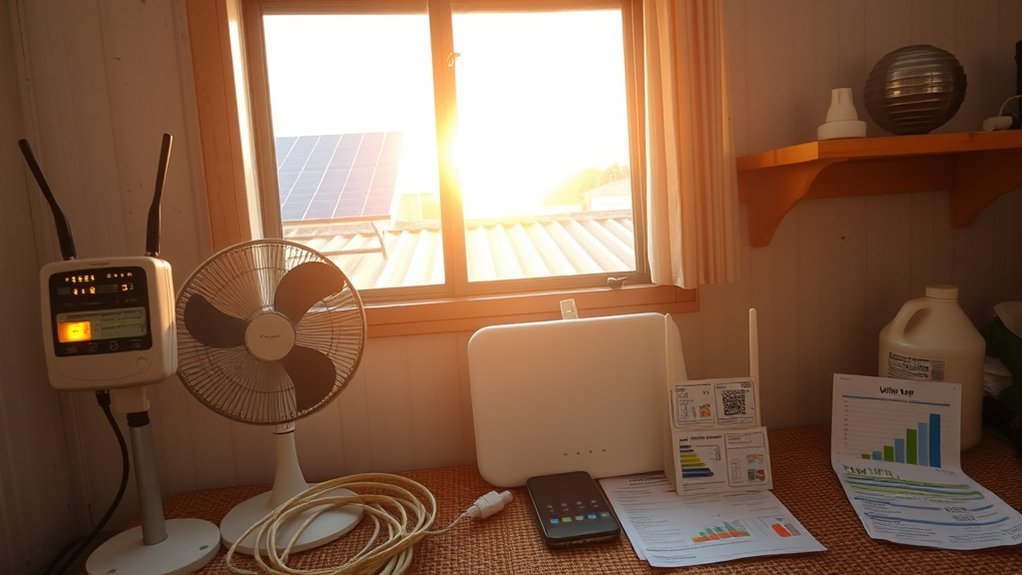
When you compare everyday living costs, utilities and connectivity in Kiribati are relatively affordable: a single person’s average utility bill runs about $40 monthly, a 50 Mbps internet plan is roughly $26.60 per month, and mobile prepaid options offer competitive per-minute rates, while local bus fares sit near $0.42 a ride.
You’ll find utilities, internet, and mobile services tend to cost less than in many neighboring Pacific markets and far lower than in major cities worldwide. Your monthly essentials (power, water, trash) cluster around that $40 figure, keeping the basic cost of living moderate.
Internet at $26.60 for 50 Mbps is serviceable for work, streaming, and communication. Mobile services rely on prepaid plans with competitive per-minute pricing, so you can control spending.
Public transport adds low commuting expenses. Compare these line items when budgeting to see how connectivity and basic utilities shape your total cost of living in Kiribati.
- Average utilities: ~$40/month
- 50 Mbps internet: ~$26.60/month
- Mobile: prepaid, competitive rates
- Local bus: ~$0.42/ride
- Connectivity lowers overall cost of living
Healthcare, Insurance, and Personal Care
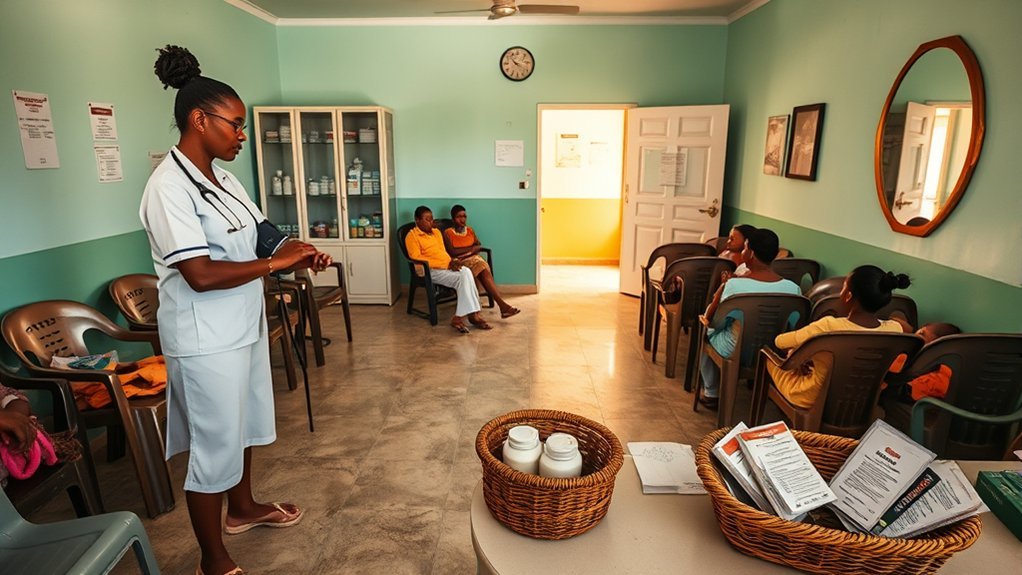
You’ll find public healthcare in Kiribati provides basic services but limited specialist care, so complex treatments often mean travel and extra expense.
Private insurance for expats typically starts around AU$50/month but varies widely with coverage limits and international evacuation options.
Compare local service gaps and insurance premiums against regional alternatives to estimate true out-of-pocket risk.
Public Healthcare Availability
Although the government provides most public healthcare in Kiribati, services are concentrated in urban centers and rural facilities are sparse, so you’ll often face longer travel times and limited treatment options.
You’ll see public healthcare availability tied to a roughly 5% GDP allocation, which improves capacity but leaves gaps compared with regional peers. Health insurance exists but isn’t widely used, so public clinics get overcrowded.
Communicable diseases and malnutrition remain prevalent, underscoring pressure on primary care and referral systems. Personal care goods vary by island, affecting out-of-pocket spending.
- Expect longer travel and referral times from outer islands
- Government funds boost urban services more than rural ones
- Low uptake of health insurance increases public demand
- Communicable diseases drive routine clinic visits
- Personal care items show wide price variance
Private Insurance Costs
Given limited public services outside urban centers and frequent out-of-pocket costs for referrals or imported personal care goods, many residents and expats look to private health insurance to fill gaps.
You’ll find private insurance costs vary: basic plans start around $50 per month, rising with inpatient, evacuation, or specialist coverage.
Healthcare services on-island remain limited, so expats often buy broader plans to secure timely access to regional hospitals.
Routine medical consultations cost about $30 without insurance, so a modest plan can pay off after a few visits.
Compare providers on premiums, deductibles, evacuation limits and networks; factor in higher prices for toiletries and shipped personal care items.
Research reduces surprise bills and aligns cover with expected use of medical consultations and services.
Salaries, Purchasing Power, and Salary Adjustment
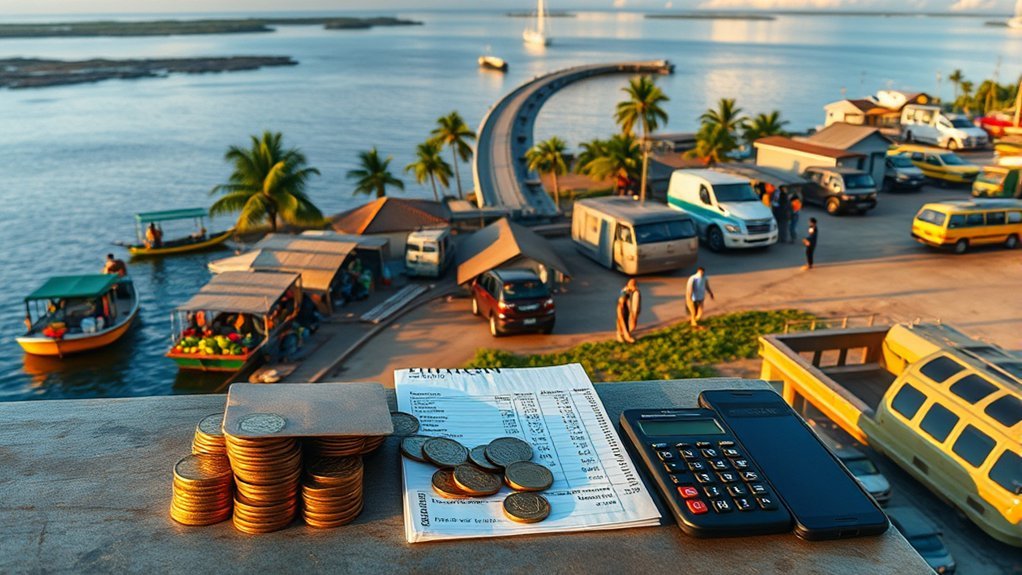
While salaries in Kiribati average just $408 after taxes, that income typically only covers about 0.8 months of local living costs. So your purchasing power will look very different than in many countries.
You’ll note GDP per capita of $2,289 and a human freedom index of 4.2, which together signal constrained economic opportunities and limited freedoms that affect wage growth.
Compared with many economies, Kiribati is 2.15 times less expensive than the world average, so raw salary comparisons mislead unless you use a cost of living calculator.
- Use a salary adjustment or cost of living calculator to convert offers and compare purchasing power.
- $408 median take-home pay vs. local costs shows tight margins for most residents.
- Lower nominal prices don’t fully offset low incomes for imported goods and services.
- GDP per capita and freedom index explain structural limits on wage increases.
- For relocations, model scenarios with salary adjustment factors and price baskets to quantify real income.
Tips for Saving Money and Finding Affordable Housing
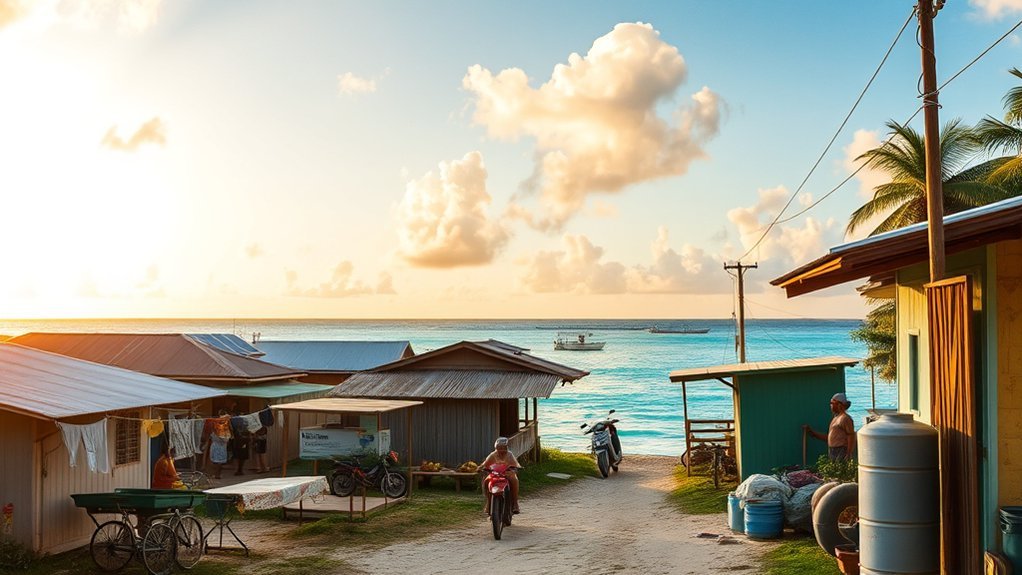
If you want to cut living costs in Kiribati, prioritize shared housing and long-term rentals—expats commonly halve accommodation expenses by sharing, and monthly rates vary widely by island so comparison matters.
You should evaluate shared housing options first: many expats report finding affordable accommodations that meet needs while reducing per-person housing costs.
Compare long-term rental markets across islands; research shows amenities and prices can differ greatly, so a cheaper island rental may offset higher transport or food costs.
Use local communities and expat groups to identify budget units, seasonal deals, and reliable landlords.
For short stays, factor hostel and budget hotel averages (~$50/night) against occasional luxury rates (~$200/night) to decide whether a longer lease saves money.
Watch seasonal pricing fluctuations in urban centers where tourism and local demand spike housing costs.
Actively negotiate longer leases and share utilities to maximize savings and stability in Kiribati’s variable housing market.
Frequently Asked Questions
Is Kiribati Expensive to Live?
No, you won’t find Kiribati expensive; cost comparison shows lower living expenses versus global averages. You’ll benefit from affordable housing prices, cheap groceries and transport, reflecting a modest local economy and overall budget-friendly lifestyle.
What Is the Average Income in Kiribati?
“Where there’s a will, there’s a way.” You earn an average salary of about $408/month in Kiribati; economic factors and limited job opportunities constrain income, so cost comparison shows lower living costs but tighter purchasing power.
Is Kiribati Worth It?
It can be worth it if you value cultural experiences, local cuisine, outdoor activities and community lifestyle; compared to many places you’ll get affordability and authentic living, but limited income, services and lifespan trade-offs reduce appeal.
What Is the Daily Life Like in Kiribati?
You’ll experience relaxed daily routines, strong cultural traditions, and simple local cuisine; transportation options are cheap. Compared to many places, meals and transit cost less, housing is affordable, but salaries limit disposable income.
Conclusion
Living in Kiribati costs more than many Pacific neighbors: your monthly basics often run around $600–$900 USD, about 20–40% higher than in nearby Fiji when adjusted for local wages. One striking stat: imported food can make up to 60% of grocery bills, pushing costs up despite low rent in outer islands. With modest salaries, you’ll need careful budgeting or remittances to match living standards common elsewhere in Oceania.

